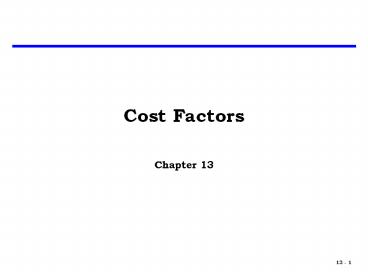Cost%20Factors PowerPoint PPT Presentation
Title: Cost%20Factors
1
Cost Factors
- Chapter 13
2
Introduction
- We tend to think of cost estimating relationships
(CERs) as complex equations with a number of
independent variables. - However, a CER can be as simple as a ratio
between two variables. - A CER in which COST is directly proportional to a
single independent variable is known as a COST
FACTOR. - A Cost Factor is expressed as either a ratio or a
percentage, and is used as a multiplier of an
independent variable. - Examples
- POL costs (POL Factor) x (Miles traveled)
- SE/PM costs (SE/PM Factor) x (Recurring
hardware) - Software costs (Software Factor) x (Lines of
Code)
3
Cost Factor Development
- Identification of cost drivers
- Miles traveled causes POL cost
- Recurring hardware causes SE/PM cost
- Lines of code causes software cost
- Specification
- It is assumed the relationship is LINEAR, and the
intercept is zero. - Selection of analogous systems
- Analogous systems should have the same cost
driver, and follow a similar functional form.
4
Cost Factor Development
- Data Collection
- Collect ACTUAL cost data, not BUDGET data.
- Normalization
- Usually no need to normalize for inflation
(unless data spans multiple years), since the
factor is represented as a percentage. - Still need to normalize for quantity, e.g., T1.
5
Example
- Suppose we want to estimate the EMD peculiar
support equipment (PSE) cost for the (new)
APG-195 radar. - We are currently in the Program Definition and
Risk Reduction (PDRR) phase of acquisition, and
have no detailed description of the PSE other
than that it will be similar to previous systems
such as the APG-180. - Consultation with technical experts has led us to
believe the PSE cost is driven by recurring
hardware (Prime Mission Equipment). - EMD cost data were collected on six radar systems
which are analogous to the APG-195.
6
Example
APG-180 Cost Performance Report
7
Example
- For contracts that are not yet complete, use LRE
costs. - The PSE cost factor is calculated as follows
8
Example
- Assume that after calculating the factors from
each of the six analogous systems our results
look like the following
- Judgment now plays a role in whether we
- Average the factors
- Select an individual factor
- Use some other method
- On the other hand, what if our factors looked
more like this? - Would you still take an average?
- Does our original assumption hold true?
9
Strengths Weaknesses
- There are often times when we have limited
visibility into the task that we are estimating. - Sometimes we need to fill in a hole in our
estimate - Another use of cost factors is as a sanity check
of the primary estimating methodology. - The Cost Factor methodology has often been
criticized for its simplicity. But remember the
principle of parsimony. All else being equal,
use the simplest technique available. - Also remember that this is but one of several
tools in the cost estimators toolbox.

